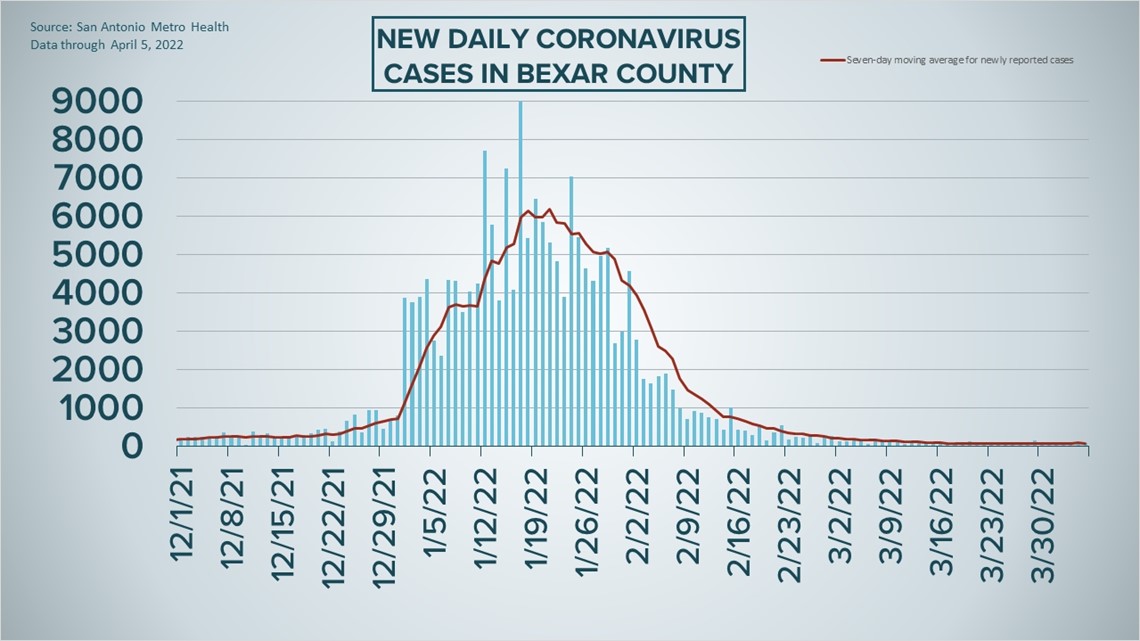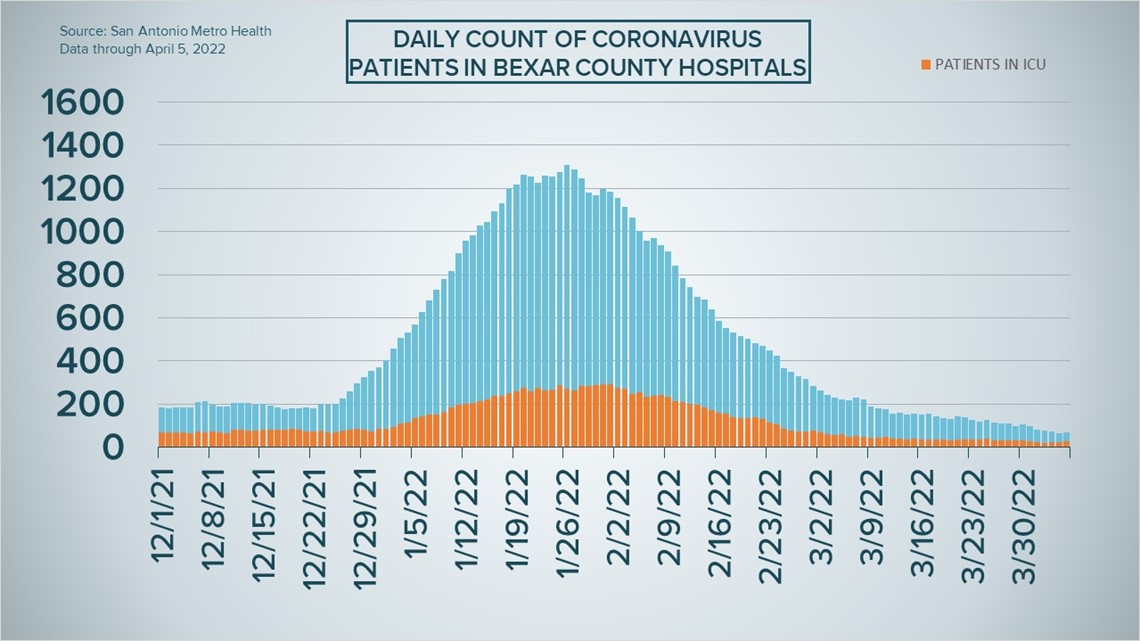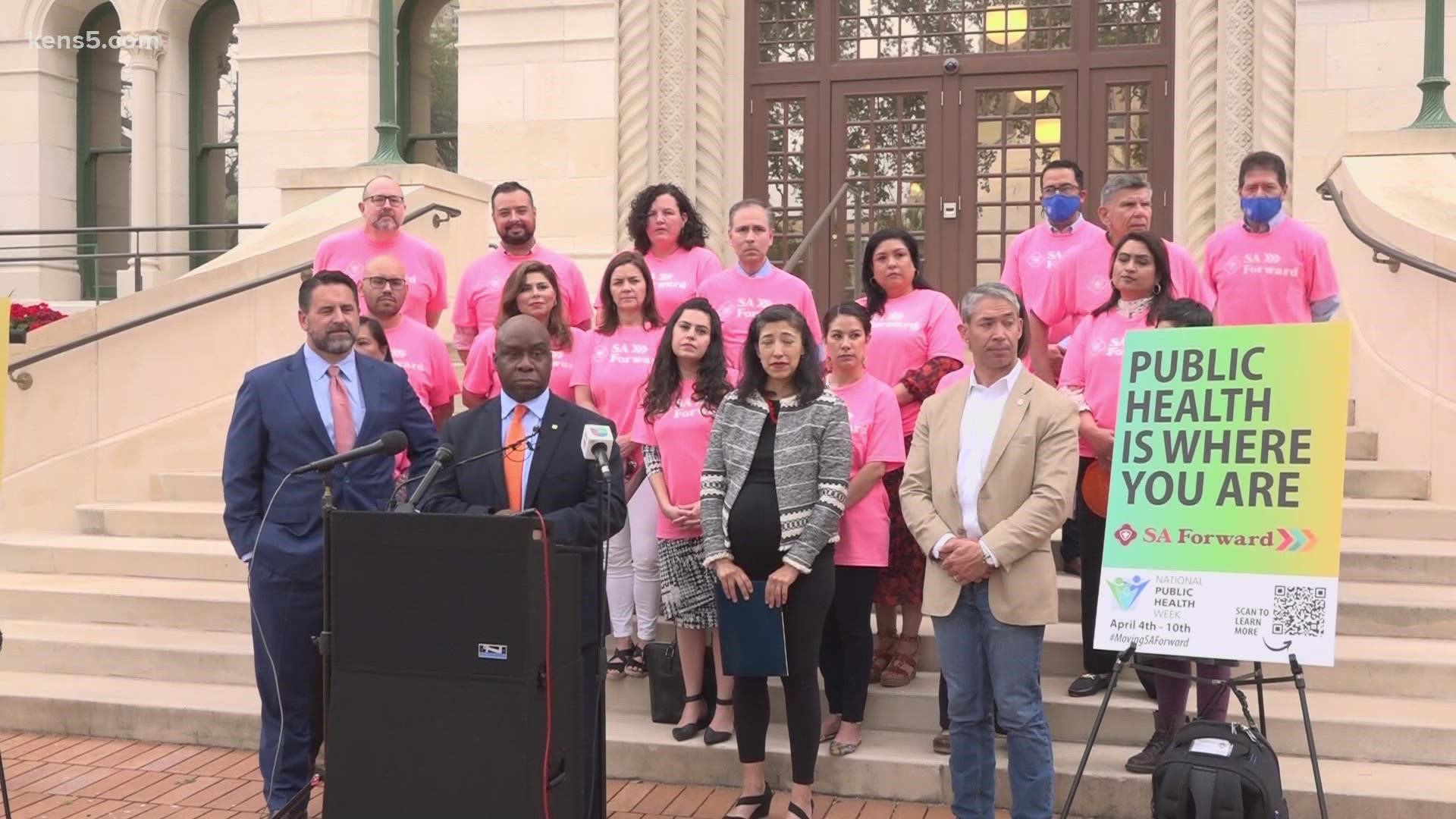SAN ANTONIO — Local COVID-19 hospitalizations are at their lowest levels in nearly two years and Bexar County virus risk remains "low," according to Metro Health officials.
While the country braces for a potential spring surge in cases from BA.2, the contagious omicron subvariant, health authorities reported just 80 new cases and two additional virus-related deaths for the San Antonio area on Tuesday. March averaged 90 new infections a day, compared to 935 in February and nearly 4,800 in January.
Nearly 535,000 Bexar County residents have been infected with the coronavirus since the pandemic began.
Meanwhile, 69 patients were battling COVID-19 symptoms in local hospitals on Tuesday. Though it's a slight increase over Monday, the number is down 69% over the last month and 83% since the start of the year, when there were over 400 local hospitalizations.
Of those 69 patients, 26 are in intensive care and 12 are using ventilators to help them breathe.
How Bexar County is trending




Vaccine Progress in Bexar County
The following numbers are provided by San Antonio Metro Health. A full breakdown can be found here.
- 1.438 million eligible Bexar County residents are fully vaccinated as of Monday, March 28.
- More than 492,000 eligible Bexar County residents have received their COVID-19 booster shot, as of Monday, March 28.
The CDC states that "when a high percentage of the community is immune to a disease (through vaccination and/or prior illness)," that community will have reached herd immunity, "making the spread of this disease from person to person unlikely."
The City of San Antonio breaks down the vaccination rates by zip code on Metro Health's Vaccination Statistics page.
Coronavirus in Texas
The total number of coronavirus cases in the state since the pandemic began grew by 2,399 on Tuesday, according to the Texas Department of State Health Services. That total includes 1,325 new confirmed cases and 1,074 new probable cases. More details can be found on this page.
Tuesday's figures bring the total number of Texans diagnosed with COVID-19 to more than 6.679 million.
An additional 21 Texans have died from virus complications, meanwhile, raising the statewide death toll to 86,096.
Coronavirus symptoms
The symptoms of coronavirus can be similar to the flu or a bad cold. Symptoms include fever or chills, cough, shortness of breath or difficulty breathing, fatigue, muscle or body aches, headache, new loss of taste or smell sore throat, congestion or runny nose, nausea or vomiting, and diarrhea, according to the Centers for Disease Control.
Most healthy people will have mild symptoms. A study of more than 72,000 patients by the Centers for Disease Control in China showed 80 percent of the cases there were mild.
But infections can cause pneumonia, severe acute respiratory syndrome, kidney failure, and even death, according to the World Health Organization. Older people with underlying health conditions are most at risk.
Experts determined there was consistent evidence these conditions increase a person's risk, regardless of age:
- Chronic kidney disease
- COPD (chronic obstructive pulmonary disease)
- Obesity (BMI of 30 or higher)
- Immunocompromised state (weakened immune system) from solid organ transplant
- Serious heart conditions, such as heart failure, coronary artery disease, or cardiomyopathies
- Sickle cell disease
- Type 2 diabetes
- The CDC believes symptoms may appear anywhere from two to 14 days after being exposed.
Human coronaviruses are usually spread...
- Between people who are in close contact with one another (within about 6 feet).
- Through respiratory droplets produced when an infected person coughs, sneezes or talks. These droplets can land in the mouths or noses of people who are nearby or possibly be inhaled into the lungs.
- Some recent studies have suggested that COVID-19 may be spread by people who are not showing symptoms.
Help stop the spread of coronavirus
- Stay home when you are sick.
- Eat and sleep separately from your family members
- Use different utensils and dishes
- Cover your cough or sneeze with your arm, not your hand.
- If you use a tissue, throw it in the trash.
Find a Testing Location
City officials recommend getting a COVID-19 test if you experience fever or chills, cough, shortness of breath or difficulty breathing, fatigue, muscle or body aches, headache, new loss of taste or smell, sore throat, congestion or runny nose, nausea or vomiting, or diarrhea.
Here's a Testing Sites Locator to help you find the testing location closest to you in San Antonio.
Latest Coronavirus Headlines
- Medicare enrollees can now get free at-home COVID tests at drug stores
- Vaccine shots that were scheduled to be trashed in Texas are, instead, saving lives in Mexico
- Biden receives 2nd booster as US launches covid.gov site
- Experts warned COVID would hurt students' mental health. Now, teachers are living that reality
- Poll: Americans ease up on masks, virus safeguards
- Senate strikes $10 billion deal on COVID-19 relief
- Biden spokesperson tests positive for COVID-19 after Europe trip
- Biden orders new research push on treating, understanding long COVID

